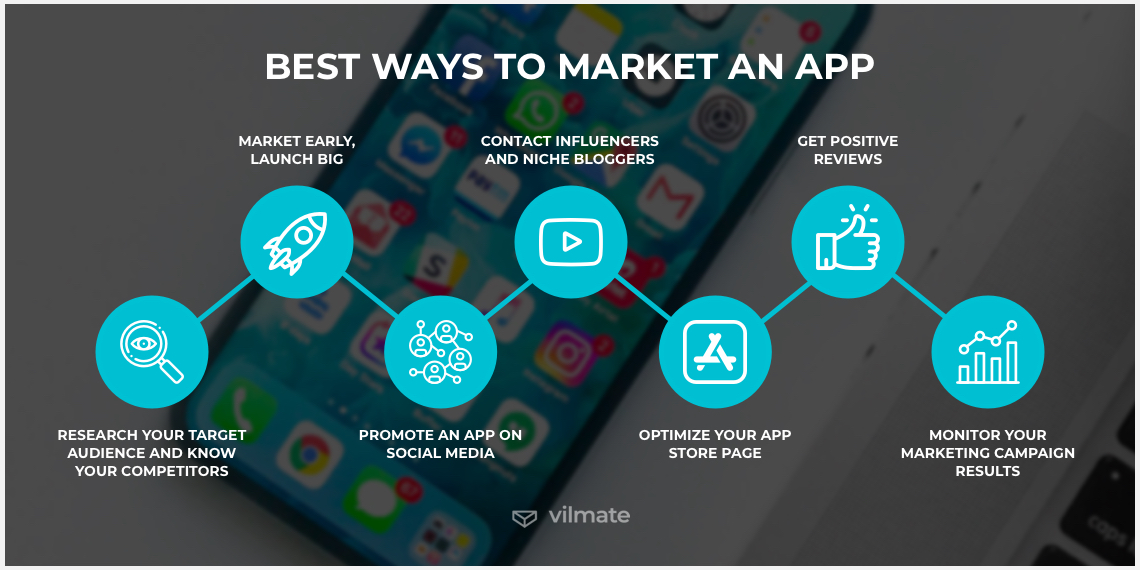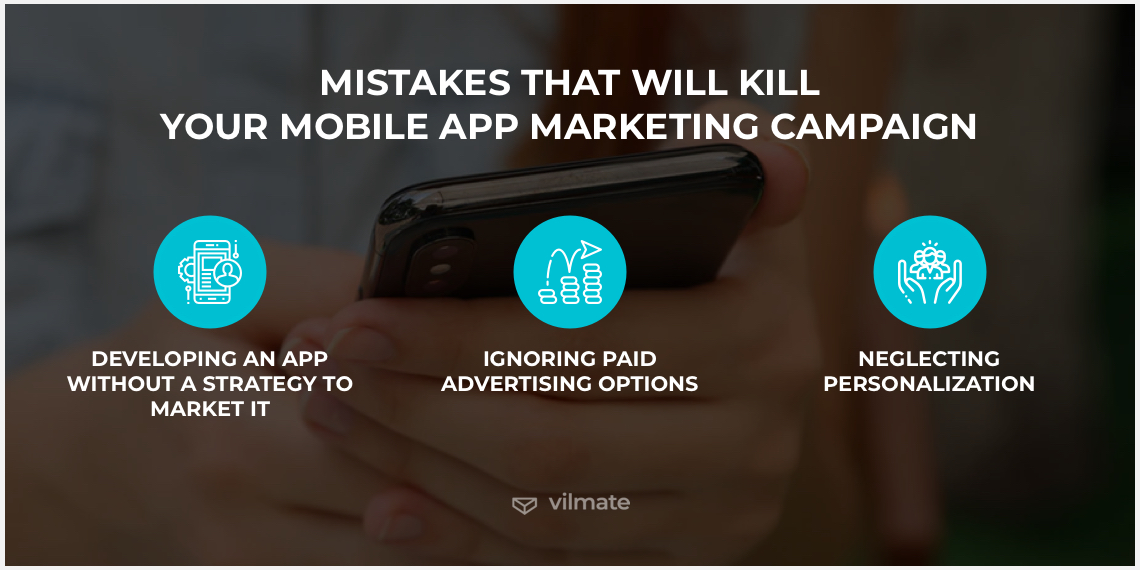However useful a mobile app that you’ve built is, it can easily get lost and be never discovered by its target audience unless you develop an effective mobile app marketing strategy and make your product visible.
What is mobile app marketing and why do it?
Mobile app marketing is a series of events that one strategically undertakes at every turn of the marketing funnel to make a mobile application reach the target users. Besides, to be deemed successful, an app must be used. So, the primary aim of mobile app promotion is not only to connect a brand with its customers but also keep them engaged. In the era of distraction, the all-important path to engagement gets thorny. For an app to actually come in view of users and to not become irrelevant or forgotten overnight, one has to take decisive but reasonable app marketing efforts. Frequent nudges, supported by intelligent mobile app marketing tools, will help you grab customer attention.
Best ways to market an app
Keeping in mind the identified lines of effort of your future mobile app marketing campaign — customer acquisition and customer retention, let’s find out how to meet prospects wherever they are in their lifecycle journeys. Thus, we’d like to share a compilation of the 7 best app marketing ideas that you could go by when developing your mobile app marketing plan template.

1. Research your target audience and know your competitors.
A mobile app is a product created by people for people. This is why all the successful mobile app marketing campaigns start by drawing a big picture of who interacts with an app and what your market competition is like. Create a profile of your customer. Gather demographic and psychographic information. Learn more about the habits and lifestyles of your users. Then you will be able to lure in your target audience, and by doing so, give your customer loyalty a boost and increase your chances to make people stay. In turn, knowing the competition, you will be able to identify and evaluate their marketing tactics. Aware of what makes other strategies workable and what undermines the effort, you will manage to improve your offer and navigate the common challenges.
2. Market early, launch big
Although the actual marketing of your product starts after an app is released, the app launch plan must be developed in advance and preferably include pre- and post-launch phases. As mentioned in the previous paragraph, one of the most important pre-launch activities is a mobile app marketing research. However, it is also a good idea to try to build up users’ interest and awareness of your presence and intentions as a brand before launching an application. Short videos like diaries, teasers, and trailers might help you with that. In fact, Gartner claims that by 2023, consumers will watch 20% fewer minutes of video ads and brands will have to adapt to that. Then, a pre-launch advertising campaign like this should be followed by an equally grand launch. The success criterion is your app being listed in the “What’s hot” section on the app stores. To get there, you must from day one be as visible as possible.
3. Promote an app on social media
Visibility should rather be gained before releasing an app. So, our advice is to start building your social media presence before your app is available for download or purchase. Social media can contribute to your popularity. So, how to promote an app on social media? For a new app, being noticed on social media is not only about extending its prospect user base, but it is also all about positioning itself as conversational, approachable, and easy-going. Social networks like Facebook, Twitter, and Instagram will let you make conversation with your users as if they were your friends. Be creative and intriguing when posting updates. For instance, you can use Twitter’s allowed 280-characters format to demonstrate all your wit. Consider creating videos, graphics, and infographics for your campaign to be noteworthy and engaging.
4. Contact influencers and niche bloggers
In-depth articles, written blog post reviews, or video interviews can sometimes do more for your mobile app promotion than social media as a platform do. So-called opinion leaders may help you with that. You should understand how important it is to generate and increase your positive referrals. Involve writers in the niche, influencers from YouTube, Twitter, and other platforms.
The more people talk about your product, the better it is for your iOS or Android app marketing strategy. This form of word-of-mouth marketing, especially when it is targeted and insightful, can prove to be more permanent and effective than social media marketing. However, there is another option. You can try and combine social media and influencer marketing efforts. According to the 2019 Influencer Marketing Report by SocialPubli.com, most marketers believe that the best way to boost product visibility is to involve influencer marketing, social media ads, and SEO, with the influencer marketing impact on the return on investment being the most significant (35%).
5. Optimize your app store page
An app store optimization (ASO) strategy is a good thing to have in place when it’s nearly time to release your mobile application. This strategy is, in many regards, similar to optimizing websites for search engines. What differs ASO from SEO is that to let people find your app on official app stores faster, you have to take a sequence of steps that is still complex but has its peculiarities.
Besides putting the right words into an app title, subtitle, and description, you also have to think through the text structure (make sure to include the relevant text in the What’s New, Promotional Text and Description sections), optimize your icon and graphics and use localizations that are indexed in your target geo. As an option, you can consider creating a video intro to your app and posting it on Google Play or App Store. If you do so, do not experiment with the layout of the graphics in the store. If screenshots are vertical, the video has to be vertical, too. Be consistent.
To crown it all, try running tests to find the most effective graphics and localized text for your app. The thing is that A/B tests, which can be easily run on Google Play as part of your Android app marketing strategy, are not allowed on the App Store. Luckily, instead, you can use a feature of Apple Search Ads called Creative Sets Testing. Then, you will be 100% sure that what users will see on your app store page is going to bring you conversions.
6. Get positive reviews
Not only ratings and reviews affect how your app ranks in search. They also influence users’ first impressions of your mobile app. Ratings and reviews are both the result and the reason for newcomers to stay. The fight for positive reviews begins earlier than you might think. When the app development is in progress yet, the development team should factor in ways in which the future app will be providing great user experience. If the UX of an app is not good enough, any of the following recommendations will be of much value to your digital marketing strategy.
When an app is good and stable, feel free to start fostering positive energy around your product. First, give users an easy way to provide feedback. Allow them to submit reviews through a standardized prompt, but do not be annoying. Think strategically and ask your users to leave a rating on the app store after they’ve finished at least a couple of sessions. Last but not least, make it possible for users to build a constructive dialogue with you in case they’ve had an unpleasant experience, let them know you care and want to resolve the problem encountered.
7. Monitor your marketing campaign results
The answer to the question of how to market an app successfully will not be simple. Your marketing campaign can’t be reduced to algorithms, predictability, and numbers. It is not a sequence of well-defined instructions by following which you can make your application a big hit. It must be tracked, and analytics must be regularly checked. Measure your KPIs like app downloads, app session length, the average number of daily and monthly active users, the number of each user’s daily sessions, and retention rate. Keeping an eye on the dynamics of your marketing campaign, you’ll see what tactics work for you and what has to be changed in your strategy.
Mistakes that will kill your mobile app marketing campaign
While some of your competitors will expect thousands of users to download their apps once they appear on the app stores, the reality is quite different. You have to be more thorough, and an app launch plan must be more exquisite. Otherwise, nothing will happen. That is why we’d like to share some common mistakes that you may make and some advice on what to do instead.

1. Developing an app without a strategy to market it
According to Statista, a mobile application user retention rate in 2019 has been the lowest since 2012. In general, the level of retention across verticals slightly exceeds the 30% threshold. It means that even if users discover and install your mobile app, the majority will soon disengage from you. So, why risk and defy luck when your chances are already not really high? Without app promotion, all your efforts will be wasted. Mobile app marketing services are a spectrum. So, what can we add to all the above recommendations?
-
If your company has a website, consider adding a call-to-action button on your website’s footer that would forward the site visitors to the official app store pages.
-
Try promoting your app offline: contributing as a speaker or involving guerrilla marketing.
-
Find partners: it can be teaming up with another application or contributing to other websites as a guest blogger.
2. Ignoring paid advertising options
When you ensure the best practices for launching an app are put into practice, your app is stable, and you are ready for user acquisition, it’s time to consider rolling out paid ads. Organic channels that we’ve discussed before can get you downloads and help you win new loyal customers, no doubt. Yet, it will be more effective to use both organic and paid channels to acquire and convert users. Your marketing campaign should include a mix of approaches, and we insist that paid mobile app promotion ads have to be part of this mix.
The mentioned Apple Search Ads, Google AdWords, Facebook, Instagram, or Twitter ads — there’re options to choose from, and they all can work for you. First, think through which way you’d better go to reach your target audience. Look through success stories that different mobile app developers attribute to any of the said paid mobile app marketing services. For example, on its official website, Apple shares stories of how using Apple Search Ads helped many applications to gain traction.
3. Neglecting personalization
The quality of your mobile application and the user experiences delivered must be the highest priority that all future marketing efforts will be centered around. This means you must do your research for a target audience and establish two-way communication with users. It must be intuitively clear that your mobile app will provide excellent customer service and satisfy the needs of a user as a single individual. Your marketing campaign has to promise (but not overpromise) nearly the same.
Personalization tactics can be deployed in a number of ways. For example, audience segmentation lets brands advertise their products or services to the right people. Mobile app marketing is now focused on groups of people that share demographic similarities or segment audiences that are defined by their activities on the web and by their passion points. It is a simple and effective way to market an app that high-profile companies like Amazon or Netflix have already taken advantage of and smaller market players use to create their personalized campaigns.
Conclusion
There’s no universally applicable mobile app marketing strategy that can drive the popularity of each and every mobile application. However, our recommendations may help you find your voice in which you will speak to your users and define the most lucrative marketing channel that you should prioritize.

© 2020, Vilmate LLC




